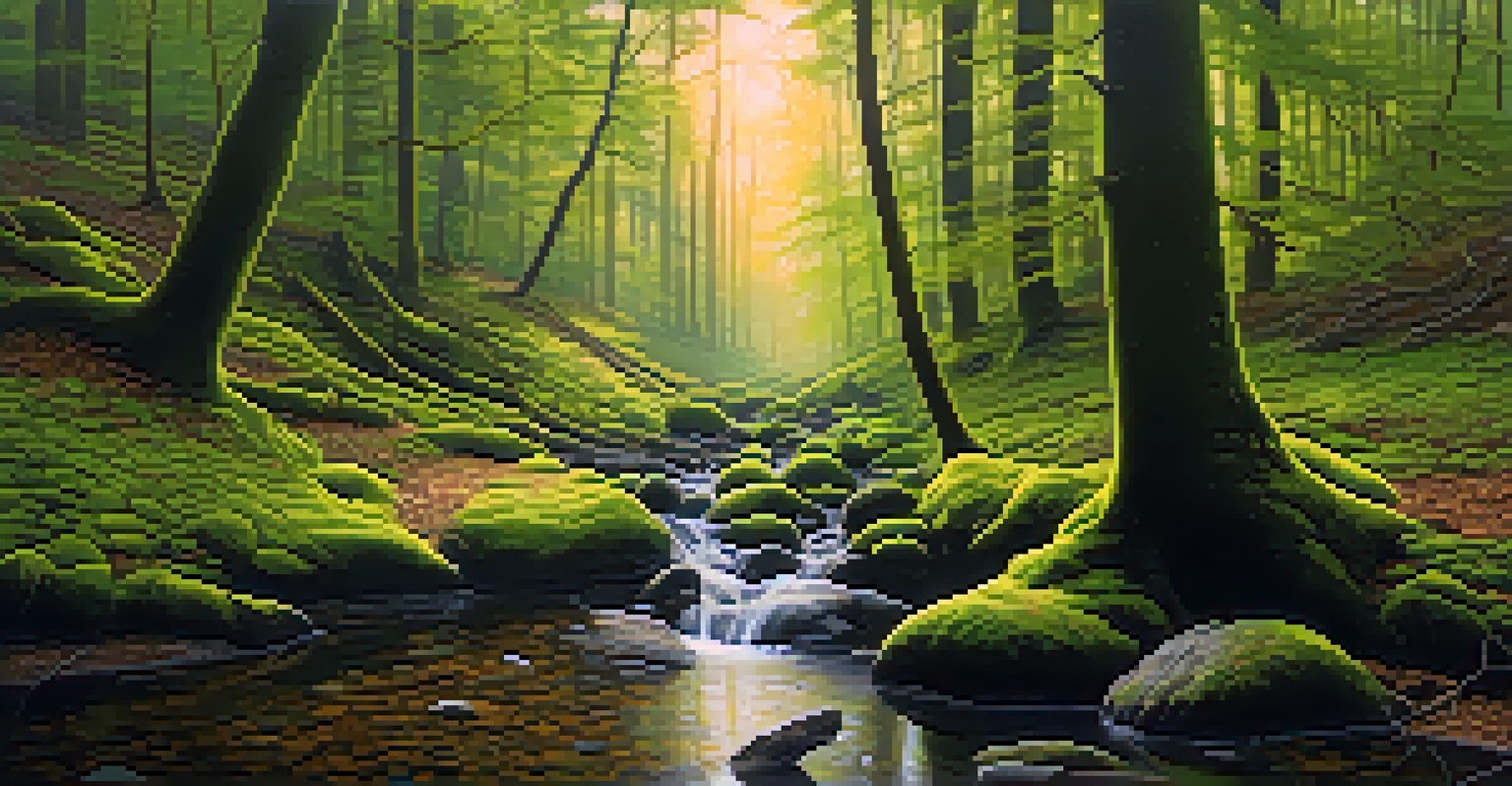How Sound Design Complements Film Scores in Creating Atmosphere

Understanding the Role of Sound Design in Film
Sound design is a critical element of filmmaking that goes beyond just music. It encompasses everything from sound effects to ambient noises, all of which contribute to the storytelling process. Think of sound design as the invisible thread weaving through a film, enhancing the visual narrative and emotional impact. Without it, scenes can feel flat or unengaging, leaving the audience disconnected from the story.
The sound of a film is a crucial part of the storytelling process, bringing depth and texture to the narrative.
In many cases, sound design sets the tone and mood before a single note of the score is played. For example, the eerie sound of creaking doors or distant thunder can instantly create a sense of suspense. This synergy between sound design and film scores is essential to crafting a compelling atmosphere that resonates with viewers.
By combining sound design with musical scores, filmmakers can evoke specific emotional responses, guiding the audience’s feelings and reactions throughout the film. This layered approach is what makes sound design so integral to the cinematic experience.
The Relationship Between Sound Design and Film Scores
Sound design and film scores share a symbiotic relationship that enhances the overall viewing experience. While scores provide the melodic backbone, sound design adds texture and depth, creating a fuller soundscape. Imagine watching a thrilling chase scene; the heartbeat-like score heightens the tension, while the whooshing sounds of passing cars and footsteps ground the audience in the action.

This relationship is often intentional, with sound designers and composers working closely together during production. They collaborate to ensure that elements complement each other seamlessly, leading to a cohesive auditory experience. A well-crafted film score can elevate sound design and vice versa, making each moment more impactful.
Sound Design Enhances Storytelling
Sound design weaves through a film, adding depth and emotional resonance to the visual narrative.
Ultimately, both elements serve to immerse the audience in the film's world, allowing them to feel the characters' emotions and experiences more profoundly. It's this interplay that transforms a standard film into an unforgettable journey.
Creating Atmosphere: The Power of Ambient Sound
Ambient sound plays a pivotal role in establishing the atmosphere of a film. These subtle background sounds—like rustling leaves, distant chatter, or city noises—help to create a sense of place and time. For instance, the gentle sound of waves lapping against the shore can transport viewers to a serene beach, while the clamor of a bustling market can evoke the energy of a vibrant city.
Sound design is not just about making sounds; it’s about creating an emotional experience.
By layering ambient sounds beneath the score, filmmakers can cultivate a richer environment that feels alive and dynamic. This layering technique draws viewers in, allowing them to experience the film's setting as if they were part of it. It’s the difference between merely watching a film and truly feeling like you're inside it.
The delicate balance between ambient sound and musical score is crucial; too much of either can overwhelm the other. When executed well, however, they harmonize beautifully, creating an immersive atmosphere that captivates the audience.
Using Sound Design to Enhance Emotional Impact
Sound design is an incredibly powerful tool for evoking emotions in film. The right sound effects can amplify the emotional weight of a scene, whether it’s a heart-wrenching moment or a thrilling climax. For example, the sound of a glass shattering can symbolize a relationship breaking apart, while a swelling score can amplify feelings of joy or triumph.
By carefully selecting and designing sound elements, filmmakers can guide the audience's emotional journey. A sudden silence, for instance, can create tension before a dramatic moment, while a soft, melodic score can evoke nostalgia. This emotional manipulation is a key reason why sound design and film scores are often inseparable.
Collaboration Boosts Auditory Experience
The symbiotic relationship between sound designers and composers creates a cohesive auditory landscape that captivates audiences.
Moreover, sound design can evoke personal memories and associations, making the film's emotional impact even more profound. This personal connection is what keeps viewers engaged and invested in the story.
The Impact of Silence in Sound Design
Silence is often an underappreciated yet powerful tool in sound design. A sudden absence of sound can create a tense atmosphere that heightens anticipation and draws the audience’s attention. For example, in horror films, a moment of silence can make viewers hold their breath, waiting for the next shocking event.
This strategic use of silence can work in tandem with a film score, creating a stark contrast that enhances emotional moments. By allowing silence to linger, filmmakers can emphasize the impact of the music that follows, making it more poignant. Audiences are left hanging on every note, their emotions amplified by the stark absence of sound.
Silence, when used effectively, can also provide a moment of reflection for viewers, allowing them to process the events on screen. This balance between sound and silence is crucial in crafting a rich cinematic experience.
Case Studies: Successful Integration of Sound Design and Scores
Many films have successfully demonstrated the powerful integration of sound design and scores. Take 'Inception,' for example; Hans Zimmer’s score, coupled with the film’s intricate sound design, creates a multi-layered auditory experience that mirrors the complexity of its plot. The iconic 'BRRRRRR' sound becomes a recurring motif, effectively interweaving with the score to heighten tension and drama.
Similarly, in 'A Quiet Place,' sound design plays a crucial role in the film’s narrative. The absence of sound amplifies the tension, while the score enhances the emotional stakes, making every noise feel significant. This clever use of sound design not only complements the score but also becomes a character in its own right.
Future Innovations in Sound Design
Emerging technologies and new viewing habits are set to transform how sound design and film scoring enhance cinematic storytelling.
These examples illustrate how a harmonious blend of sound design and film scores can elevate a film, making it more memorable and impactful. The careful consideration of both elements leads to a richer storytelling experience that resonates long after the credits roll.
The Future of Sound Design and Film Scoring
As technology continues to evolve, so too does the field of sound design and film scoring. Innovations in audio technology, such as immersive sound systems and virtual reality, are paving the way for more complex soundscapes. This evolution allows filmmakers to create experiences that are not only seen but felt, pushing the boundaries of traditional storytelling.
Moreover, the rise of streaming platforms has changed how audiences consume film, leading to new opportunities for sound design and scores. With more viewers watching on headphones or surround sound systems, the attention to detail in audio design has never been more critical. Filmmakers must adapt to these changes, ensuring that the sound design and score are tailored for varied viewing environments.

Looking ahead, we can expect to see more innovative collaborations between sound designers and composers, leading to even richer cinematic experiences. The future holds exciting possibilities for how sound can continue to enhance storytelling in film.